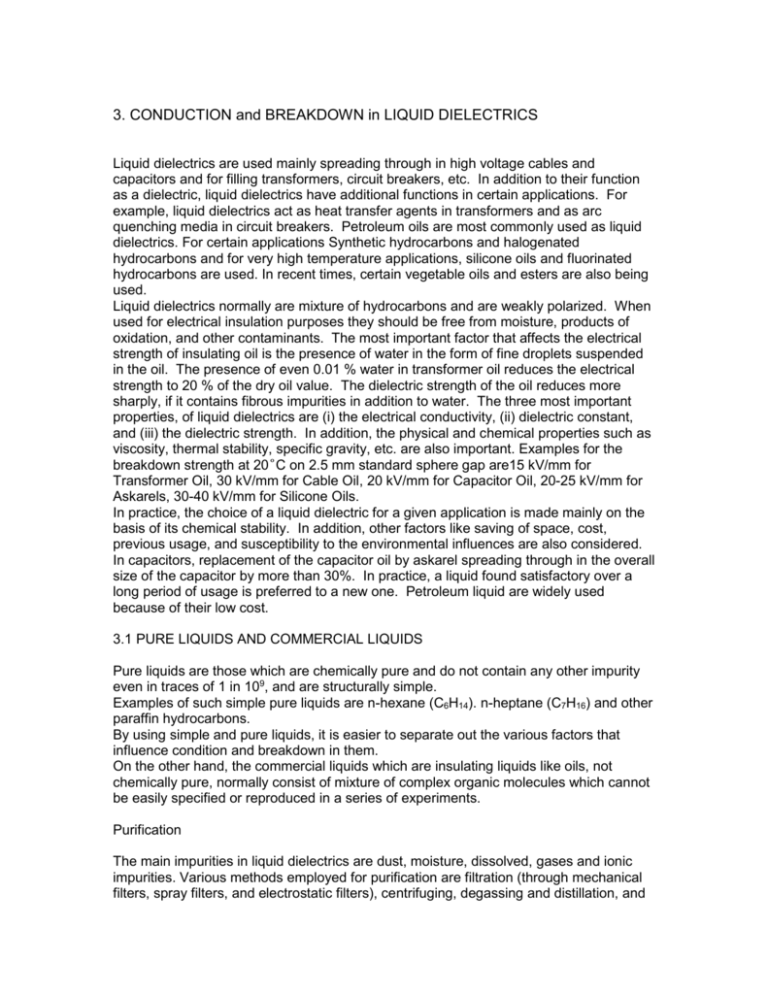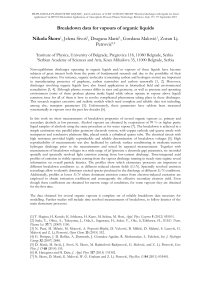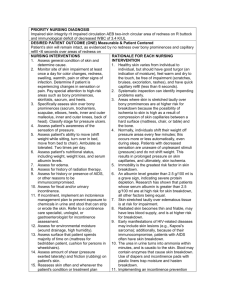CHAPTER 3
advertisement

3. CONDUCTION and BREAKDOWN in LIQUID DIELECTRICS Liquid dielectrics are used mainly spreading through in high voltage cables and capacitors and for filling transformers, circuit breakers, etc. In addition to their function as a dielectric, liquid dielectrics have additional functions in certain applications. For example, liquid dielectrics act as heat transfer agents in transformers and as arc quenching media in circuit breakers. Petroleum oils are most commonly used as liquid dielectrics. For certain applications Synthetic hydrocarbons and halogenated hydrocarbons and for very high temperature applications, silicone oils and fluorinated hydrocarbons are used. In recent times, certain vegetable oils and esters are also being used. Liquid dielectrics normally are mixture of hydrocarbons and are weakly polarized. When used for electrical insulation purposes they should be free from moisture, products of oxidation, and other contaminants. The most important factor that affects the electrical strength of insulating oil is the presence of water in the form of fine droplets suspended in the oil. The presence of even 0.01 % water in transformer oil reduces the electrical strength to 20 % of the dry oil value. The dielectric strength of the oil reduces more sharply, if it contains fibrous impurities in addition to water. The three most important properties, of liquid dielectrics are (i) the electrical conductivity, (ii) dielectric constant, and (iii) the dielectric strength. In addition, the physical and chemical properties such as viscosity, thermal stability, specific gravity, etc. are also important. Examples for the breakdown strength at 20˚C on 2.5 mm standard sphere gap are15 kV/mm for Transformer Oil, 30 kV/mm for Cable Oil, 20 kV/mm for Capacitor Oil, 20-25 kV/mm for Askarels, 30-40 kV/mm for Silicone Oils. In practice, the choice of a liquid dielectric for a given application is made mainly on the basis of its chemical stability. In addition, other factors like saving of space, cost, previous usage, and susceptibility to the environmental influences are also considered. In capacitors, replacement of the capacitor oil by askarel spreading through in the overall size of the capacitor by more than 30%. In practice, a liquid found satisfactory over a long period of usage is preferred to a new one. Petroleum liquid are widely used because of their low cost. 3.1 PURE LIQUIDS AND COMMERCIAL LIQUIDS Pure liquids are those which are chemically pure and do not contain any other impurity even in traces of 1 in 109, and are structurally simple. Examples of such simple pure liquids are n-hexane (C6H14). n-heptane (C7H16) and other paraffin hydrocarbons. By using simple and pure liquids, it is easier to separate out the various factors that influence condition and breakdown in them. On the other hand, the commercial liquids which are insulating liquids like oils, not chemically pure, normally consist of mixture of complex organic molecules which cannot be easily specified or reproduced in a series of experiments. Purification The main impurities in liquid dielectrics are dust, moisture, dissolved, gases and ionic impurities. Various methods employed for purification are filtration (through mechanical filters, spray filters, and electrostatic filters), centrifuging, degassing and distillation, and chemical treatment (adding ion exchange material such as alumina, fuller’s earth etc. filtering). Dust particles when present become charged and reduce the breakdown strength of the liquid dielectrics, and they can be removed by careful filtration. Liquid will normally contain moisture and dissolved gases in small quantities. Gases like oxygen and carbon dioxide significantly affect the breakdown strength of the liquids, and hence it is necessary to control the amount of gas present. This is done by distillation and degassing. Ionic impurity in liquids, like water vapor which easily dissociates, leads to very high conductivity and heating of the liquid depending on the applied electric field. Water is removed using drying agents or by vacuum drying. Sometimes, liquids are shaken with concentrated sulphuric acid to remove wax and residue and washed with caustic soda and distilled water. A commonly used closedcycle liquid purification system to prepare liquids as per the above requirements is shown in Fig. 3.1. Cooling tower Vacuum Gauge Vacuum Valve Distillation column To Vacuum Pump Filter To Vacuum Pump Test cell with electrodes To Vacuum Pump Reservoir Fig. 3.1 Liquid purification system with test cell. This system provides for cycling the liquids. The liquid from the reservoir flows through the distillation column where ionic impurities are removed. Water is removed by drying agents or frozen out in the low-temperature bath. The gases dissolve in the liquid are removed by passing them through the cooling tower and/or pumped out by the vacuum pumps. The liquids then passes thought the filter where dust particles are removed. The liquid thus purified is then use in the test cell. The used liquid then flows back into the reservoir. The vacuum system thus helps to remove the moisture and other gaseous impurities. Breakdown Tests Breakdown tests are normally conduced using test cell. For testing pure liquids, the test cells used are small so that less quantity of liquid is used during testing. Also, test cells are usually an integral part of the purification system as shown in Fig. 3.1. The electrodes used for breakdown voltage measurement are usually spheres of 0.5 to 1 cm in diameter with gap spacing of about 100-200 μm. The gas is accurately controlled by using a micrometer. Electrode separation is very critical in measurement with liquids, and also the electrode surface smoothness and the presence of oxide films have a marked influence on the breakdown strength. The test voltages required for these tests are usually low, of the order of 50-100 kV, because of small electrode spacing. The breakdown strengths and d.c conductivities obtained in pure liquids are very high, of the order of 1 MV/cm and 10-18-10-20 mho/cm respectively, the conductivity being measured at electric field of the order of 1 kV/cm. However, the corresponding values in commercial liquids are relatively low. 3.2 CONDUCTION AND BREAKDOWN IN PURE LIQUIDS When low electric fields less than 1 kV/cm are applied, conductivities of 10-18 -10-20 mho/cm are obtained. These are probably due to the impurities remaining after purification. However, when the fields are high (>100kV/cm) the currents not only increase rapidly, but also undergo violent fluctuations which will die down after some time. A typical mean value of the conduction current in hexane is shown in Fig. 3.2. This is the condition nearer to breakdown. Conduction 14 Current 11 (A x 10 ) 12 10 8 6 4 2 0 0.4 0.6 0.8 1.0 1.2 Electric field (MV/cm) Fig.3.2 Conduction current-electric field characteristics in hexane at high fields However, if this figure is redrawn starting from very small currents, a current-electric field characteristics as shown in Fig. 3.3, can be obtained. This curve will have three distinct regions as shown. At very low fields the current is due to the dissociation of ions. With intermediate fields the current reaches a saturation value, and at high fields the current generated because of the field-aided electron emission from the cathode gets multiplied in the liquid medium by a Townsend type of mechanism .The current multiplication also occurs from the electrons generated at the interfaces of liquid and impurities. The increase in current by these processes continues till breakdown occurs. The exact mechanism of current growth is not known; however, it appears that the electrons are generated from the cathode by field emission of electrons. Conduction Current (Arbitrary units) Field aided saturation ionic 0 0.2 0.4 0.6 0.8 1.0 Electric field (MV/cm) Fig.3.3 Conduction current-electric field characteristics in hydrocarbon liquid The electrons so liberated get multiple by a process similar to Townsend’s primary and secondary ionization in gases As the breakdown field is approaches, the current increases rapidly due to process similar to the primary ionization process and also the positive ions reaching the cathode generate secondary electrons, leading breakdown. The breakdown voltage depends on the field, gap separation, cathode work-function, and the temperature of the cathode. In addition, the liquid viscosity, the liquid temperature, the density, and the molecular structure of the liquid also influence the breakdown strength of the liquid. Typical maximum breakdown strengths of some highly purified liquids and liquefied gases are given in Table 3.1. Table 3.1 Maximum Breakdown strength of some liquid Liquid Hexane Benzene Transformer oil Silicone Liquid Oxygen Liquid Nitrogen Liquid Hydrogen Liquid Helium Liquid Argon Maximum breakdown strength (MV/cm) 1.1-1.3 1.1 1.0 1.0-1.2 2.4 1.6-1.9 1.0 0.7 1.1-1.42 It has observed that the increase in breakdown strength is more, if the dissolved gases are electronegative in character (like oxygen). Similarly, the increase in the liquid hydrostatic pressure increases the breakdown strength. To sum up, this type of breakdown process in pure liquids, called the electronic breakdown, involves emission of electrons at fields greater than 100 kV/cm. This emission occurs either at the electrode surface irregularities or at the interfaces of impurities and the liquid. These electrons get further multiplied by Townsend’s type of primary and secondary ionization processes, leading to breakdown. 3.3 CONDUCTION AND BREAKDOWN IN COMMERCIAL LIQUIDS As already mentioned commercial insulating liquids are not chemically pure and have impurities like gas bubbles, suspended particles, etc. These impurities reduce the breakdown strength of these liquids considerably. The breakdown mechanisms are also considerably influenced by the presence of these impurities. In addition, when breakdown occurs in these liquids, additional gases and gas bubbles are evolved and solid decomposition products are formed. The electrode surfaces become rough, and at times explosive sounds are heard due to the generation of impulsive pressure through the liquid. The breakdown mechanism in commercial liquids is dependent on several factors, such as, the nature and condition of the electrodes, the physical properties of the liquid, and the impurities and gases present in the liquid. Several theories have been proposed to explain the breakdown in liquids, and they are classified as follows: a) Suspended Particle Mechanism b) Cavitation and Bubble Mechanism c) Stressed Oil Volume Mechanism a. Suspended Particle Theory In commercial liquids, the presence of solid impurities cannot be avoided. These impurities will be present as fibres or as dispersed solid particles. The permittivity of these particles 2 will be different from the permittivity of the liquid 1 . If we consider these impurities to be spherical particles of radius r, and if the applied field is E, then the particles experience of force F, where 1 F= r 3 2 1 grad E 2 2 2 1 2 (3.1) This force is directed towards areas of maximum stress, if 2 1 , for example, in the case of the presence of solid particles like paper in the liquid. On the other hand, if only gas bubbles are present in the liquid, i.e. 2 1 , the force will be in the direction of areas of lower stress. If the voltage is continuously applied (d.c) or the duration of the voltage is long (a.c), then this force drives the particles towards the area of maximum stress. If the number of particles is large, they become aligned due to these forces, and thus form a stable chain bridging the electrode gap causing a breakdown between the electrodes. If there is only a single conducting particle between the electrodes, it will give rise to local field enhancement depending on its shape. If this field exceeds the breakdown strength of the liquid, local breakdown will occur near the particle, and this will result in the formation of gas bubbles which may lead to be breakdown of the liquid. The value of the breakdown strength of the liquids containing solid impurities was found to be much less than the values for pure liquids. The impurity particles reduce the breakdown strength, and it was also observed that the larger the size of the particles the lower were the breakdown strengths. b. Cavitation and the Bubble Theory It was experimentally observed that in many liquids, the breakdown strength depends strongly on the applied hydrostatic pressure, suggesting that a change of phase of the medium is involved in the breakdown process, which in other words means that a kind of vapor bubble formed is responsible for breakdown. The following processes have been suggested to be responsible for the formation of the vapor bubbles: a) Gas pockets at the surface of the electrodes; b) electrostatic repulsive forces between space charges which may be sufficient to overcome the surface tension; c) gaseous products due to the dissociation of liquid molecules by electron collisions; and d) Vaporization of the liquid by corona type discharges from sharp points and irregularities on the electrode surfaces. Once a bubble is formed it will elongated (long and thin) in the direction of the electric field under the influence of electrostatic forces. The volume of the bubble remains constant during elongation. Breakdown occurs when the voltage drop along the length of the bubble becomes equal to the minimum value on the Paschen’s curve for the gas in the bubble. The breakdown field is given as 1 2 2 2 1 2 1 Vh E0 1 r 1 2 (2rE0 ) (3.2) where is the surface tension of the liquid, 1 is the permittivity of the liquid, 2 is the permittivity of the gas bubble, r is the initial radius of the bubble assumed as a sphere and Vb is the voltage drop in the bubble (corresponding to minimum on the Paschen’s curve). From this equation it can be seen that the breakdown strength depends on the initial size of the bubble which in turn is influenced by the hydrostatic pressure and temperature of the liquid. But this theory does not take into account the production of the initial bubble and hence the results given by this theory do not agree well with the experimental results. Later this theory was modified, and it was suggested that only incompressible bubbles like water globules can elongate at constant volume, according to the simple gas law pv = nRT. Under the influence of the applied electric field the shape of the globule is assumed to be approximately a spheroid. These incompressible bubbles reach the condition of instability when , the ratio of the longer to the shorter diameter of the spheroid is about 1.85, and the critical field producing the instability will be: 1 G H (3.3) where surface tension, R= initial radius of 1 R 1 2 bubble, 1 permittivity of the liquid dielectric, 1 permittivity of the globule, E0 600 1 cosh 1 G 2 1 and 1 1 2 1 2 1 1 H 2 2 3 2 1 2 For a water globule having R=1 m with 43dyne/cm and 1 2.0 (transformer oil), the above equation gives a critical field E c 226 Kv / cm which is approximately the maximum strength obtained for commercial oils. In the case of gas bubbles the equation for the critical field is rewritten as A= 2 1 1 2 1 1 3 2 8A 2 B 4 2 where, B=2 1 2 1 E c 600 1R 1 G cosh 1 2 3 1 2 1 2 G, and R are as above for liquid globules, and 1 3 2 5 1 PR 27 1 2 cosh -1 3 2B 3 where P is the hydrostatic pressure. (Equations 3.2-3.4 are in c.g.s. units). The expressions are quite complicated, and the breakdown voltages were obtained using a computer. Results thus obtained showed good agreement with the experimental results in n-hexane. This theory suggests that sub-microscopic particles (diameter 100-250 A) and bubbles greatly influence the maximum electrical strength attainable in commercial liquids. The critical condition is reached when cavities are formed due to zero pressure conditions given by Pc Pvp Pes Ps Ph , (3.5) Pc coulombic pressure, Pvp vapour pressure inside the cavity, where, Pes electrostatic pressure, Ps pressure due to surface tension, and Ph hydrostatic pressure. From this condition, an expression has been obtained for the maximum breakdown strength of pure liquids which was found to be in good agreement with the experimental results. In general, the cavitation and bubble theories try to explain the highest breakdown strengths obtainable, considering the cavities or bubbles formed in the liquid dielectrics. Thermal Mechanism of Breakdown Another mechanism proposed to explain breakdown under pulse conditions is thermal breakdown. This mechanism is based on the experimental observations of extremely large currents just before breakdown. These high current pulses are believed to originate from the tips of the microscopic projections on the cathode surface with densities of the order of 1A/cm2 . These high density current pulses give rise to localized heating of the oil which may lead to the formation of the vapor bubbles. The vapor bubbles are formed when the energy exceeds 107 W/cm3 . When a bubble is formed, breakdown follows, either because of its elongation to a critical size or when it completely bridges the gap between the electrodes. In either case, it will result in the formation of a spark. According to this mechanism, the breakdown strength depends on the pressure and the molecular structure of the liquid. For example, in n-alkanes the breakdown strength was observed to depend on the chain length of the molecule. This theory is only applicable at very small lengths 100 m and does not explain the reduction in breakdown strength with increase gap lengths. c. Stressed Oil Volume Theory In commercial liquids where minute traces of impurities are present, the breakdown strength is determined by the “largest possible impurity” or “weak link”. On a statistical basis it was proposed that the electrical breakdown strength of the oil is defined by the weakest region in the oil, namely, the region which is stressed to the maximum and by the volume of oil included in that region. In non-uniform fields, the stressed oil volume is taken as the volume which is contained between the maximum stress Emax contour and 0.9 Emax contour. According to this theory the breakdown strength is inversely proportional to the stressed oil volume. The breakdown voltage is highly influenced by the gas content in the oil, the viscosity of the oil, and the presence of other impurities. These being uniformly distributed, increase in the stressed oil volume consequently results in a reduction in the breakdown voltage. The variation of the breakdown voltage stress with the stressed oil volume is shown in Fig. 3.4. Breakdown Stress 400 (kV/cm) 300 With steady voltage rise 200 one minute withstand voltage 100 0 10-2 1.0 102 104 106 Stressed oil volume (cc) Fig 3.4 Power frequency (50 Hz) a.c breakdown stress as function of stressed oil volume 3.4 CONCLUSIONS All the theories discussed above do not consider the dependence of breakdown strength on the gap length. They all try to account for the maximum obtainable breakdown strength only. However, the experimental evidence showed that the breakdown strength of a liquid depends on the gap length, given by the following expression, d=gap length, Vb Ad n where, A=constant,and n=constant,always less than 1. The breakdown voltage also depends on the nature of the voltage, the mode in which the voltage is applied, and the time of application. The above relationship is of practical importance, and the electrical stress of given oil used in design is obtained from this. During the last ten years, research work is directed on the measurements of discharge inception (starting) levels in oil and the breakdown strengths of large volumes of oil under different conditions. It may be summarized that the actual mechanism of breakdown in oil is not a simple phenomenon and the breakdown voltages are determined by experimental investigations only. Electrical stresses obtained for small volumes should not be used in the case of large volumes. QUESTIONS 1. Explain the phenomena of electrical conduction in liquids. How does it differs from those in gases? 2. What are the commercial liquids dielectrics, and how are they different from pure liquids dielectrics? 3. What are the factors that influence conduction in pure liquid dielectrics and in commercial liquid dielectrics? 4. Explain the various theories that explain breakdown in commercial liquids dielectrics. 5. What is “stressed oil volume theory”, and how does it explain breakdown in large volumes of commercial liquid dielectrics?








